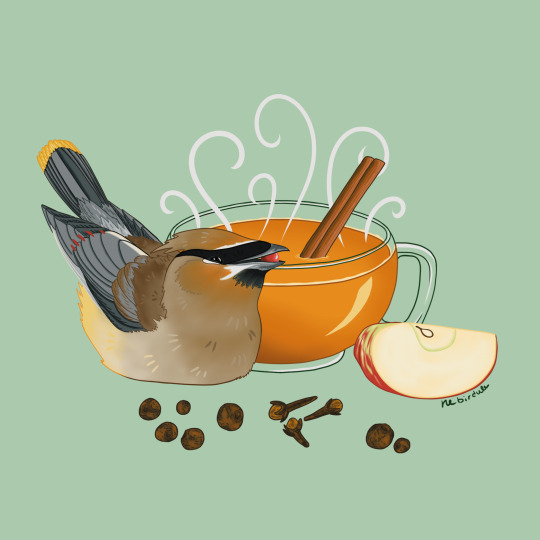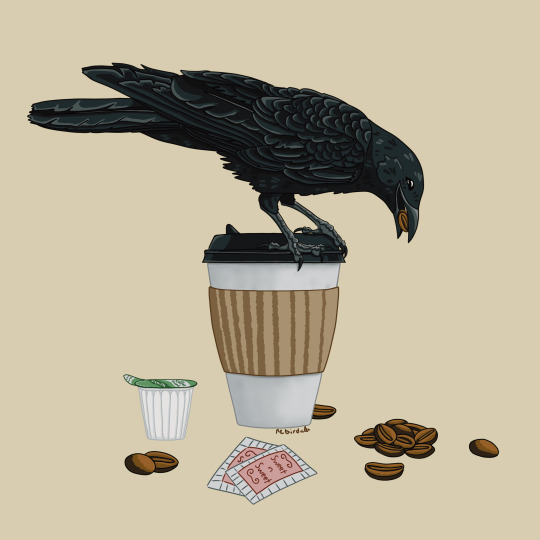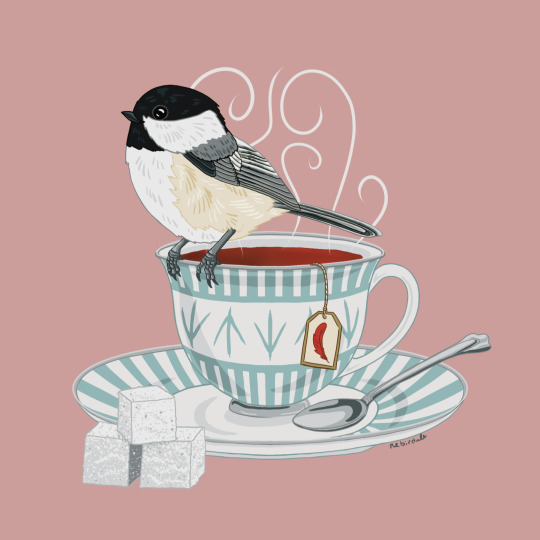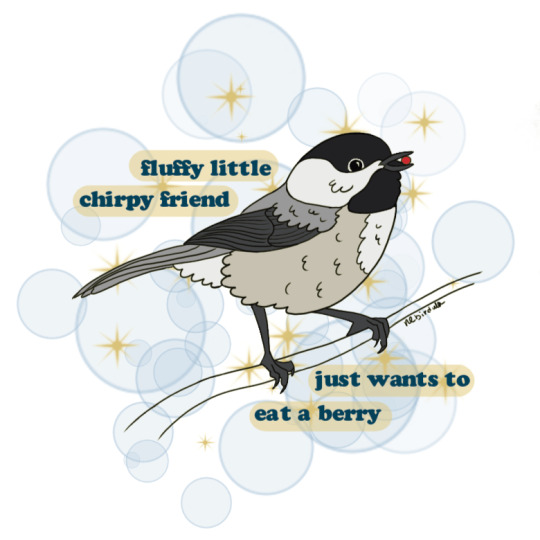Just an artist trying to find her place in the world, i like to draw creatures and things. Checkout my other blog, draweverybird, for lotsa bird drawings.
Don't wanna be here? Send us removal request.
Text




May I offer a hot birdverage? We have cocoaburra, chickatea, cawfee, or cider waxwing.
17 notes
·
View notes
Text

forest vibes pattern
10 notes
·
View notes
Text

We must always remember to be both kind to each other and righteously angry at injustice. Do not tolerate the intolerant.
9 notes
·
View notes
Text

Malayan Crested Fireback
558 notes
·
View notes
Text

A gingerbread house needs its gingerbread mouse
3 notes
·
View notes
Text

CandyCornBack Bat-Winged Amphithere
a.k.a Halloween Amphithere
This amphithere is the manifestation of Halloween. They only spawn on Halloween night, particularly when the night is clear with a full moon, and are especially attracted to areas with a high number of trick-or-treaters. They are even known to spawn right inside a bucket of candy.
These elementals are completely harmless and in fact love eating candy. If they ever bite your finger, it's probably because they thought it was a gummy candy. They say the candy corn pattern on their backs comes from people feeding them their unwanted candy corn. This is so widely believed that people often leave out a bucket full of candy corn on Halloween night to attract one of these elementals.
#digital art#artists on tumblr#halloween#creature design#amphithere#flying serpent#candy corn#halloween candy#fantasy art
8 notes
·
View notes
Text

Candy Corn Siphonophore
A species of siphonophore whose zooids look uncannily like candy corn. Alas, experts assure us that they would not taste like candy corn if eaten. Then again, no one has tried.
12 notes
·
View notes
Text

The Common Phoenix, the most widespread phoenix species. They represent wood burning fire, also known as campfire or fireplace phoenix. Their feathers are highly prized, and this phoenix species is heavily farmed for these feathers. (More info below).
Text from image:
Common Phoenix – Fire Elemental
This species of phoenix is the most widespread, found practically anywhere except Antarctica. This phoenix is the manifestation of fire that burns on wood or vegetation at around 1110℉ - 2550℉. Often called the fireplace or campfire phoenix for their common appearances around these places.
The phoenix body temperature burns fairly hot, at an average of 135℉. Despite common belief, the phoenix is not actively on fire, only bursting to flames at the very end of their life, when they can reach temperatures up to 165℉.
Life & Death
The phoenix does not reproduce sexually, nor do they have any gender. There are 2 ways the phoenix can come into being:
1. When conditions are just right and strong magic is present, a phoenix can spontaneously appear into being.
2. From an egg. The phoenix has a high resistance to heat, but their internal temperature continues to rise as they age, and they die when they can no longer withstand the heat, bursting into flames. Each phoenix produces a single egg that they carry inside them through their life. The heat and flames from the phoenix's death triggers the egg to hatch, producing a new phoenix.
Older and hotter phoenix produce feathers with dark "sooty" spots, which can be seen as either as impure or unique.
Feathers & Farming
The feathers of the common phoenix are highly prized for their color, softness, and warmth, and are the most sought out and prized part of the phoenix.
Phoenix farming is tricky since phoenix only produce one offspring per lifetime. This has led to controversial farming practices which involve killing the phoenix before they burn up and harvesting their parts after, including the feathers. The eggs from the phoenix are placed in a special incubator where they hatch from. All parts of a phoenix are sold as luxury items. This practice is opposed by many since it is believed that if an elemental is killed before it dies naturally, its magic essence cannot return to the natural world. Regardless, phoenix farming is a high profit business.
21 notes
·
View notes
Text

For junicorn I turned various farm animals into unicorns, and since it's also pride month I colored them based on different pride flags! Here we have:
A sheep/ram unicorn based on the progress flag
A pig unicorn based on the nonbinary flag
A donkey unicorn based on the trans flag
A cow unicorn based on the classic rainbow flag
Chicken unicorns based on the MLM/gay, lesbian, bisexual, and aroace flags.
(If you're wondering why the cow design is more simple, it's because somehow I forgot cows existed until very late in the process of making these designs, and I was running out of steam and didn't have it in me to do another full unicorn design, so I just did a cow with a unicorn horn.)
Happy pride!
17 notes
·
View notes
Text

Designing merfolk based on random fish species for mermay. Here's all 10 I did. I used a random fish species generator I found online to give me the fish to do these. It was a fun challenge!
10 notes
·
View notes
Text
Bird vibes are so funny, on one hand you have

but on the other hand there's

with plenty of in-between.
6 notes
·
View notes
Text

Metallic Birds (part 2 / 2). Their environment is rich in metal and some plants and animals have adapted to use the metal they ingest. These birds can grow metallic feathers and horn-like structures.
Porcupine Turkey: A large bird that grows feathers with metal shafts. The shafts grow beyond the vane, and are as sharp as needs, covering the bird in a coat of "quills." Like porcupines in our world, when threatened, these birds shake their coat of quills and turn away from the predator, pointing the sharp ends of the quills towards them. It's thought that the metal, spiked, ball-like formations on the wattle of the bird are more for show during mating season, rather than defense.
Shield-winged Dagger Quail: These birds have several defense mechanisms. First is the dagger-like horn on its head. When threatened, it lowers its head and points the horn towards the predator. Second is the wings and tail covered in all-metal feathers. The feathers are so heavy with metal that these birds cannot fly, but they act as an effective shield, both for protecting itself and its young. Some individuals have even been observed using light reflection from their wings to confuse predators.
15 notes
·
View notes
Text

Metallic Birds (part 1 / 2). Their environment is rich in metal and some plants and animals have adapted to use the metal they ingest. These birds can grow metallic feathers and horn-like structures.
Great Swordbill: Also known as a Knight Bird. A large bird that grows a sword-like horn on it's head. A large metal growth on the back of the skull acts as a counter-balance to the heavy horn. Both males and females have this horn, and it's used to forage food and crack open nuts. Males however have larger horns and use them to fend off other males during mating season. The feathers on their body contain metal filaments that curl and link together, forming a protective chain mail.
Glittering Fencer Hummingbird: This bird grows a thin, delicate horn from its head. Metal in the feathers and at the ends of long filaments glitter when they fly. Only males grow the horn, and it's to compete with other males. Certain flowers have adapted to allow the Fencer Hummingbirds easy access to the metal-rich pollen that grows inside. A slit along the top of the flowers let the birds feed without the horn getting in the way. Various species of these birds grow different metals from their body, including copper, gold, iron, etc.
Rusty Legcutter: These predatory birds grow metal tusks on either side of their beaks. Their quick runners, and they use their speed to catch large prey animals by surprise, then use their tusks to slice open their legs. Weakened, the prey are usually taken down by larger predator animals, after which the Legcutters gain access to the carcass. Legcutters have developed a habit of digging their tusks in damp dirt, which encourages rust growth. In turn, the rusty texture easily picks up dirt and bacteria. If the blood loss from the cuts don't weaken the prey, a tetanus infection will. Farmers who share land with Legcutters must wear metal-lined boots, and outfit their livestock with metal grieves, to protect themselves from the birds.
6 notes
·
View notes
Text

Got into a bit of an oryx hyper-fixation and decided to draw all the species. 'Cause oryx are cool. It helped that there aren't too many of them! This was partly a study and partly for fun. I'm quite happy with it, might do it again with another species - someday.
If it isn't clear in the text of the image, the "golden" oryx isn't it's own species, it's just a Gemsbok born with no pigment in the black parts. As soon as I saw it in my searching I knew I had to draw it!
5 notes
·
View notes
Text

A snail crossed with a hedgehog. A snedgehog!!
4 notes
·
View notes
Text

Sloth crossed with a snail. Seemed like a perfect combo to me! They're both... slow...
2 notes
·
View notes
Text

Cat crossed with a snail. More specifically, a Maine Coon cat crossed with a giant African snail. You might call it... a Giant Coon snail.
22 notes
·
View notes